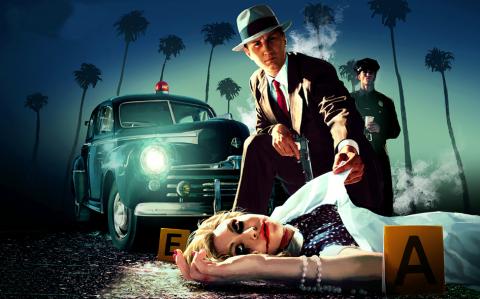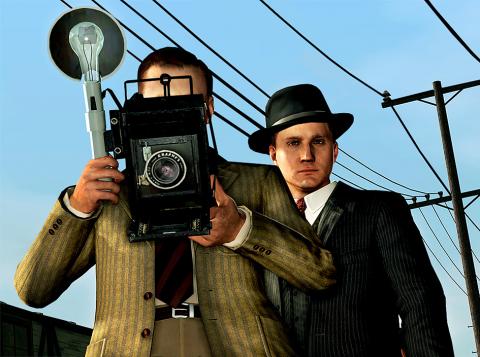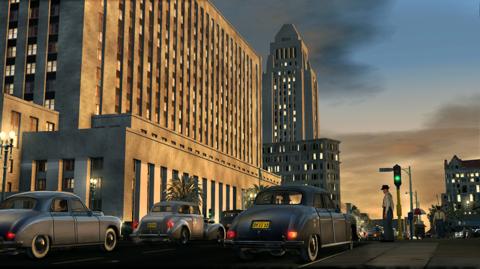Two police detectives burst into a filthy apartment. A woman is cowering on the floor amid upturned furniture as a group of hired thugs search every drawer and cupboard. A fist fight ensues, the heavies are dispatched and the officers are left to question the traumatized victim.
How do they start questioning her? How will they know if she’s telling the truth? Well, that’s your problem. You are the cop and this is a whole new type of video game.
LA Noire is the latest offering from Rockstar Games, the notorious publisher of Grand Theft Auto and last year’s brilliant western shooter, Red Dead Redemption. The action takes place in the seamy, crime-sodden LA of the late 1940s; the familiar hunting ground of Raymond Chandler, James Ellroy and Dashiell Hammett — all huge influences on the game’s director, Brendan McNamara. The player takes on the role of rookie detective Cole Phelps as he investigates a series of kidnaps and murders, studying crime scenes, talking to witnesses and interrogating suspects. Gamers are able to choose the tone of each question-and-answer session, playing nice and going in gently, or challenging every word the subject utters. Vitally, progress is made by watching characters as they stutter and squirm, judging whether they’re lying or terrified; it’s not killing people, it’s reading them.

Photo Courtesy of Rockstar Games
The realism of these virtual humans is incredible. In one scene the gamer has to question an actor who has been drugged, shoved in the back of a car and wheeled down an embankment in a thwarted murder attempt. Her eyes dart about, she shifts uncomfortably, her brows furrow in agitation — she’s hiding something. These aren’t the gross caricatures of facial expressions we’re used to in video games, they are subtle and natural. Later, the gamer talks to a weasely prop house owner who has been caught running a seedy casting coach. He snarls his way through the session, but after a few threats he wilts, his expression droops. At times, it is almost photographic.
What LA Noire represents is a new era for interactive entertainment. Over the past 30 years, games have been based around challenging the player’s hand-eye co-ordination — the ability to react quickly with a controller. But in LA Noire, the main skill is emotional perception, being able to judge body language and facial “tells” — the little nervous tics that betray liars. These are the same skills we use in real life and that allow us to engage with characters in TV and movie dramas. Suddenly then, games are a universal medium.
They have hinted at this before. Last year’s grueling psychological drama Heavy Rain required players to engage with troubled characters and carry out simple detective work, while the Mass Effect series of science-fiction adventures has provided a rich, emotional narrative. But the naturalism, the human drama of these games, has always been held back by slightly lifeless character models.

Photo Courtesy of Rockstar Games
Central to the human realism in LA Noire is the motion-scan technology, a new method of capturing facial expressions, researched and developed by the game’s creators, the Sydney-based studio, Team Bondi. Standard motion-capture means that the actor’s face is covered in small, reflective balls, which are tracked by a camera. “The problem with that is that having little balls on someone’s face doesn’t really capture the muscles or the skin movement,” says McNamara. “It just captures skeletons and there aren’t that many joints in the human face.” But with motion-scan, each actor is surrounded by 32 cameras, which record every intricate movement at the rate of 1,000 frames-per-second, creating a three-dimensional animation of the actor’s face as they deliver lines. All of this is captured in a special studio, complete with stark, white lighting: “When we first described this weird process to the actors, they thought they were going to be reprogrammed, like Alex in A Clockwork Orange,” jokes McNamara.
The casting has also been vital. Team Bondi avoided going for film superstars, because their mannerisms and emotional cues will be too familiar to gamers. Instead, they’ve opted for lesser-known actors. Aaron Staton, who plays Ken Cosgrove in Mad Men, is Phelps. “When we started looking at the roles, Dan Houser [vice-president of Rockstar Games], had seen Aaron in Mad Men and thought he was an interesting actor,” explains McNamara. “Luckily, we used the same casting agency as Mad Men, so once we had Aaron on board, half the rest of the cast heard about it and asked to be in it, too. Lots of them have cameos!”
There are over 400 characters in the game, and its script that would cover two seasons of a major TV series. But, for all this talk of human drama, LA Noire is still an action game. Between the interrogation scenes, there are shoot-outs and car chases, there are bank robberies to foil. Team Bondi claims a new style of co-operative gameplay will emerge to deal with this dichotomy. “One interesting phenomenon we’ve seen while testing the game is that three or four people will sit down and play together on a couch, with one handling the shoot-outs and the brawls, and someone else doing the conversations. It becomes an interactive experience that families might choose over half an hour of TV,” adds McNamara.

Photo Courtesy of Rockstar Games
So is there a future in which games abandon the need for visceral action altogether and concentrate on human relationships? McNamara is convinced this will happen, and, as Internet-connected televisions become more readily available, we’re going to see experiences that merge traditional TV shows with video game elements. “It’s going to happen sooner than you think,” he says. “We have shown with LA Noire the level of humanity you can get into games, the level of immersion, the believability of the characters. Games have always been good at interactivity, but where we’ve fallen down is in areas like story and characters. If we bring all that in, there’s no reason interactive TV shows couldn’t happen.”
Until recently, games were about crude characters blasting space aliens; now they can be about rounded humans learning to gauge photorealistic strangers. McNamara’s ideas about deep interactive dramas being broadcast like TV shows sound outlandish, but the technological building blocks are there. LA Noire points the way. We are going to need to put down our controllers and pick up on our people skills.
LA Noire will be released for Xbox 360 and PS3 on 20 May.

Desperate dads meet in car parks to exchange packets; exhausted parents slip it into their kids’ drinks; families wait months for prescriptions buy it “off label.” But is it worth the risk? “The first time I gave him a gummy, I thought, ‘Oh my God, have I killed him?’ He just passed out in front of the TV. That never happens.” Jen remembers giving her son, David, six, melatonin to help him sleep. She got them from a friend, a pediatrician who gave them to her own child. “It was sort of hilarious. She had half a tub of gummies,

June 23 to June 29 After capturing the walled city of Hsinchu on June 22, 1895, the Japanese hoped to quickly push south and seize control of Taiwan’s entire west coast — but their advance was stalled for more than a month. Not only did local Hakka fighters continue to cause them headaches, resistance forces even attempted to retake the city three times. “We had planned to occupy Anping (Tainan) and Takao (Kaohsiung) as soon as possible, but ever since we took Hsinchu, nearby bandits proclaiming to be ‘righteous people’ (義民) have been destroying train tracks and electrical cables, and gathering in villages

The wide-screen spectacle of Formula One gets a gleaming, rip-roaring workout in Joseph Kosinski’s F1, a fine-tuned machine of a movie that, in its most riveting racing scenes, approaches a kind of high-speed splendor. Kosinski, who last endeavored to put moviegoers in the seat of a fighter jet in Top Gun: Maverick, has moved to the open cockpits of Formula One with much the same affection, if not outright need, for speed. A lot of the same team is back. Jerry Bruckheimer produces. Ehren Kruger, a co-writer on Maverick, takes sole credit here. Hans Zimmer, a co-composer previously, supplies the thumping

Swooping low over the banks of a Nile River tributary, an aid flight run by retired American military officers released a stream of food-stuffed sacks over a town emptied by fighting in South Sudan, a country wracked by conflict. Last week’s air drop was the latest in a controversial development — private contracting firms led by former US intelligence officers and military veterans delivering aid to some of the world’s deadliest conflict zones, in operations organized with governments that are combatants in the conflicts. The moves are roiling the global aid community, which warns of a more militarized, politicized and profit-seeking trend